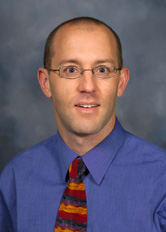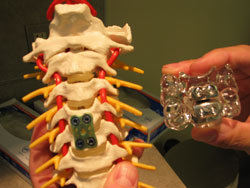 |
Peter Lennarson, M.D. |
In the largest study ever completed on the cervical spine involving 541 patients, results showed that the Prestige artificial disc had superior outcomes in terms of safety and effectiveness when compared to spinal fusion, the previous gold standard for treating degenerative disc disease. Patients receiving the artificial disc healed faster and experienced much better range of motion in the neck. The average age of patients in the study was 44.
The artificial disc, which is marketed as the Prestige Cervical Disc, was approved by the U.S. Food and Drug Administration (FDA) on July 16.
Dr. Lennarson, who is an assistant professor of neurosurgery at UNMC, was included in one of the first training classes offered by Medtronic, Inc., the Minneapolis-based firm which designed the artificial disc. He received his training in neurological surgery at the University of Iowa.
“The artificial disc provides an attractive alternative to spinal fusion,” Dr. Lennarson said. “This is something that patients have been wanting for many years.”
Patients with degenerative disc disease experience intolerable neck and/or arm pain, Dr. Lennarson said, and are extremely anxious to have the pain alleviated.
With spinal fusion, which is called Anterior Cervical Discectomy and Fusion (ACDF), the degenerated disk is removed and replaced with a plug of bone taken from either a bone graft, a human cadaver or a variety of other materials. Using a metal plate, the replacement disk is fused in between neck vertebrae. Although spinal fusion does help alleviate pain, the patient loses range of motion in the neck and healing can be quite slow, taking up to six to nine months.
 |
Peter Lennarson, M.D., displays an artificial disc (right) used in a new surgical procedure he will perform at The Nebraska Medical Center. On the left is a model depicting the fusion technique that has been the standard of care for people with degenerative disc disease. The artificial disc procedure provides quicker healing for the patient and allows range of motion for the neck — both major advances over the fusion procedure. Dr. Lennarson is the only physician in the region qualified to perform the surgery. |
“The surgical procedure for inserting the artificial disc is very similar to the spinal fusion procedure,” Dr. Lennarson said. “It doesn’t require a lot of new techniques. The procedure involves about a 1 ½-inch incision in the front of the neck, and the patient only has to stay overnight in the hospital. Since you don’t have to wait months for fusion to occur, healing occurs much faster, the patient can return to work and/or normal activities much sooner, and — best of all — the patient will have preserved neck mobility.”
More than 200,000 cervical procedures are performed each year to relieve compression problems resulting from degenerated discs.
Dr. Lennarson said the artificial disc is only approved for people with a single degenerated disc. Studies are now being done to see if the artificial disk works for people with two degenerated discs.
“We know that spinal fusion puts more stress on adjacent discs, and that it can result in needing to do additional fusions on adjacent discs,” Dr. Lennarson said. “We don’t know if this will also be the case with the artificial disc but we think the incidence will be lower. This will need to be studied over time.”
He said that the chance of having another degenerated disc at a level adjacent to a fusion is estimated to be 3 percent per year and that 25 percent of these patients will undergo an additional fusion within 10 years.
Dr. Lennarson will be performing this procedure at The Nebraska Medical Center. To schedule an appointment to determine if a patient is a candidate for the procedure, call the Neurosurgery Clinic at 559-3939 or Dr. Lennarson’s office at 559-4299.